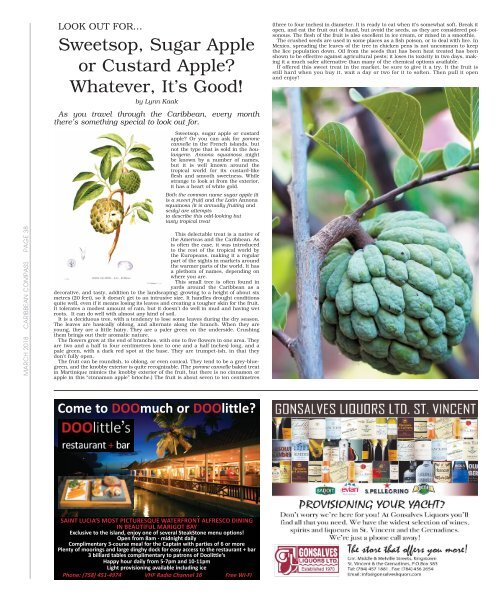Caribbean Compass Sailing Magazine - March 2018
Welcome to Caribbean Compass, the most widely-read boating publication in the Caribbean! THE MOST NEWS YOU CAN USE - feature articles on cruising destinations, regattas, environment, events...
Welcome to Caribbean Compass, the most widely-read boating publication in the Caribbean! THE MOST NEWS YOU CAN USE - feature articles on cruising destinations, regattas, environment, events...
Create successful ePaper yourself
Turn your PDF publications into a flip-book with our unique Google optimized e-Paper software.
LOOK OUT FOR…<br />
Sweetsop, Sugar Apple<br />
or Custard Apple?<br />
Whatever, It’s Good!<br />
by Lynn Kaak<br />
As you travel through the <strong>Caribbean</strong>, every month<br />
there’s something special to look out for.<br />
Sweetsop, sugar apple or custard<br />
apple? Or you can ask for pomme<br />
cannelle in the French islands, but<br />
not the type that is sold in the boulangerie.<br />
Annona squamosa might<br />
be known by a number of names,<br />
but it is well known around the<br />
tropical world for its custard-like<br />
flesh and smooth sweetness. While<br />
strange to look at from the exterior,<br />
it has a heart of white gold.<br />
Both the common name sugar apple (it<br />
is a sweet fruit) and the Latin Annona<br />
squamosa (it is annually fruiting and<br />
scaly) are attempts<br />
to describe this odd-looking but<br />
tasty tropical treat<br />
(three to four inches) in diameter. It is ready to eat when it’s somewhat soft. Break it<br />
open, and eat the fruit out of hand, but avoid the seeds, as they are considered poisonous.<br />
The flesh of the fruit is also excellent in ice cream, or mixed in a smoothie.<br />
The crushed seeds are used in some places as a fish poison, or to deal with lice. In<br />
Mexico, spreading the leaves of the tree in chicken pens is not uncommon to keep<br />
the lice population down. Oil from the seeds that has been heat treated has been<br />
shown to be effective against agricultural pests; it loses its toxicity in two days, making<br />
it a much safer alternative than many of the chemical options available.<br />
If offered this sweet treat in the market, be sure to give it a try. It the fruit is<br />
still hard when you buy it, wait a day or two for it to soften. Then pull it open<br />
and enjoy!<br />
MARCH <strong>2018</strong> CARIBBEAN COMPASS PAGE 38<br />
This delectable treat is a native of<br />
the Americas and the <strong>Caribbean</strong>. As<br />
is often the case, it was introduced<br />
to the rest of the tropical world by<br />
the Europeans, making it a regular<br />
part of the sights in markets around<br />
the warmer parts of the world. It has<br />
a plethora of names, depending on<br />
where you are.<br />
This small tree is often found in<br />
yards around the <strong>Caribbean</strong> as a<br />
decorative, and tasty, addition to the landscaping; growing to a height of about six<br />
metres (20 feet), so it doesn’t get to an intrusive size. It handles drought conditions<br />
quite well, even if it means losing its leaves and creating a tougher skin for the fruit.<br />
It tolerates a modest amount of rain, but it doesn’t do well in mud and having wet<br />
roots. It can do well with almost any kind of soil.<br />
It is a deciduous tree, with a tendency to lose some leaves during the dry season.<br />
The leaves are basically oblong, and alternate along the branch. When they are<br />
young, they are a little hairy. They are a paler green on the underside. Crushing<br />
them brings out their aromatic nature.<br />
The flowers grow at the end of branches, with one to five flowers in one area. They<br />
are two and a half to four centimetres (one to one and a half inches) long, and a<br />
pale green, with a dark red spot at the base. They are trumpet-ish, in that they<br />
don’t fully open.<br />
The fruit can be roundish, to oblong, or even conical. They tend to be a grey-bluegreen,<br />
and the knobby exterior is quite recognizable. (The pomme cannelle baked treat<br />
in Martinique mimics the knobby exterior of the fruit, but there is no cinnamon or<br />
apple in this “cinnamon apple” brioche.) The fruit is about seven to ten centimetres<br />
Come to DOOmuch or DOOlittle?<br />
SAINT LUCIA‘S MOST PICTURESQUE WATERFRONT ALFRESCO DINING<br />
IN BEAUTIFUL MARIGOT BAY<br />
Exclusive to the island, enjoy one of several SteakStone menu options!<br />
Open from 8am - midnight daily<br />
Complimentary 3-course meal for the Captain with parties of 6 or more<br />
Plenty of moorings and large dinghy dock for easy access to the restaurant + bar<br />
3 billiard tables complimentary to patrons of Doolittle‘s<br />
Happy hour daily from 5-7pm and 10-11pm<br />
Light provisioning available including ice<br />
Phone: (758) 451-4974 VHF Radio Channel 16 Free Wi-Fi


















